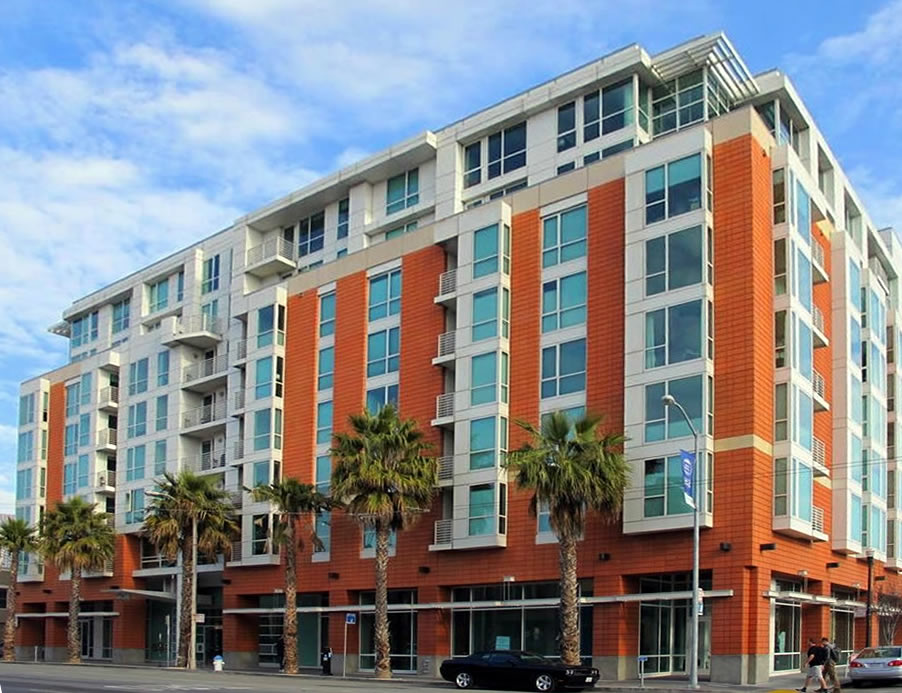Purchased for $850,000 in January of 2012, the two-story, 1,245-square-foot penthouse unit #827 at The Palms returned to the market listed for $1.399 million this past June.
Reduced to $1.299 million and alternatively offered for rent at $5,450 a month, the sale of 555 4th Street #827 has now escrow with a contract price of $1.25 million or roughly $1,004 per square foot.
On an apples-to-apples basis, that’s total appreciation of 47.1 percent or $400,000 over the past six years, which is nearly as much on an absolute basis as the previous owner’s loss of $415,000 from 2007 to 2012 as the unit was purchased as new for $1.265 million ($1,016 per square foot) in March of 2007, which was a few months before the market for SoMa condos peaked and around a year before home values in San Francisco’s more expensive neighborhoods – including Noe, Bernal and the various Hills – turned in the second half of 2008.








Alas Unit 831 hasn’t sold in seven months. Construction maybe?
Wow. That’s some huge appreciation over the last 4 years. Kudos to the seller!
Any idea what a similar sized investment in the S&P 500 would have yielded over the same period of time? The index was at 1,289 when this unit was purchased in 2012, at which point the market rent was $4,000 per month and the HOA dues were $492.
Very difficult to know without access to their tax returns. Are those available?
Sure, whatever the s&p return was, cut it by 80% for a fair comparison. Most RE purchases are leveraged with loans, 20-30% down, so the returns usually cream stocks. And that isn’t including any tax write offs, not paying down the loan. No question the 2012 buyer did very well here.
Surely levering up heavily and buying at the bottom works out very well. But what about levering up heavily and buying at the top??
You would do poorly. But you also have to know when the top is. People have been talking about the impending collapse of the SF RE market for years. While they’ve been talking, this seller made $400k.
I don’t think anyone thought that 2012 was the top. And I don’t think any of the participants in the frenzied overbidding of a few years past were talking about the impending collapse of the market.
There are far more people saying “they’ve been saying that for years” than there are actual people who had been saying that for years.
Good point. Maybe it was only people on this website who have been proclaiming the impending SFRE collapse.
While comparing two investments, assuming one is leveraged and the other is not, is standard practice in marketing brochures, if one is not comparing returns on an unleveraged basis, one should at least leverage both investments appropriately when comparing the two.
And of course, don’t forget to take into account the relative transaction and holding costs associated with each.
investing is stocks consistently beats RE over the long term.
Not with leverage it does not. Especially prime Bay Area properties.
Depends on the stocks and the real estate. (And the leverage.)
Many transactions were all cash after the crash. Though it may have improved by 2012, chances are that the seller put down more than 20%.
Sfrealist- obvs, I’m talking about averages.
SFcommie- not really. Transactions between 2009-2011 were mostly cash, but there weren’t that many, compared to 2012- now. And most of those peeps got loans.
I have a weird feeling that the seller could really care less about the price somebody else paid in 2007.
I think this shows a few problems with the “Don’t worry about buying at the top, just hold on to the next peak” line.
First off had the 2007 buyer held on, they would have been burdened with much higher holding costs only to suffer a slight loss after a 10 year hold and then transaction costs would have taken a chunk out of that.
Secondly, there’s the Gambler’s Ruin problem. Even if prices recover, a particular individual may not recover. Especially in the late stages of a bubble when people are leveraging up to get into the market at very high prices, they may have very limited capacity to weather a downside. Overconfidence may peak along with prices right when the risk is highest (Prices in SF have never/will never go down, Anyone looking to get under 2016 prices will be disappointed,…)
Thirdly, The fall of the 2007-era bubble was arrested by a massive set of government bailouts and intervention by the Fed and other central banks. There’s no guarantee that the next cycle will be anywhere near as large in amplitude as the 2007&2017 cycles. In particular, the politics of bailing out high priced coastal regions is very very different from the decision to bail out the entire US economy.
Yes, I recall when we first started thinking about moving (in 2008) many telling us “you can’t time the market so don’t try.” This was at a time when prices were already falling pretty much everywhere, and it was absolutely clear that the risks of waiting were far smaller than the potential rewards of waiting. By January 2012, coincidentally when we bought our current place, the calculus was far different with the risks of further price declines now pretty low. The imminent decline was not quite so clear in March 2007 when this place was purchased, although $1016/sf for this place was way, way out of line for a place like this in a cheap building. Dunno, but maybe they had one of the popular nothing down loans and didn’t really take a hit; the bank and taxpayers did. I’d put the risks of purchasing now higher up on the scale than 2012 certainly, although nowhere near 2007-08, and the potential rewards much higher than 2007-08 as well as the economy continues to hum along.
“The imminent decline was not quite so clear in March 2007 when this place was purchased”
Yes, even though valuations were way out of line back then and consumer overconfidence and a blindness to risk made the economy look much better than it really was, very few people perceived any signs of trouble to come.
“This was at a time when prices were already falling pretty much everywhere, and it was absolutely clear that the risks of waiting were far smaller than the potential rewards of waiting.”
And this is why once prices even start to slope down a bit, the cycle can reverse with a vengeance. Most buyers come to the same conclusion that you did and do not want to buy into a falling market, reducing demand. And sellers eventually come to the same conclusion from their POV and start to realize that the rewards of waiting are far smaller then the risks of waiting.
“once prices even start to slope down a bit, the cycle can reverse with a vengeance”
True it can reverse with a vengeance, but that is a very rare phenomenon. Happened in 2007 with housing. But the many, many housing downturns before that were very limited. Home buyers do not typically move en masse into some risk aversion mindset. Nearly all are just looking for someplace to live. That is why the brief plateau of late 2016 (or decline if you believed socketsite) and late 2014 did not turn into a downward cascade. Like markets generally, when prices decline a little, a lot of people look at that as a buying opportunity and prop things up again. Nothing new there – just Econ 101. Same thing with stocks, Greek bonds, or about 1000 other markets one could name. The notion that any little downturn will necessarily turn into a big rout – because nobody wants to buy into a falling market – has it precisely backwards as a general principle.
“but that is a very rare phenomenon”
That’s not at all true. What made the 2007 (and possibly 2017) cycles unique was their national scope and their out-sized amplitude. But there have been many regional housing cycles prior to that. In fact, one of the ironies hanging your hat on the Case-Shiller index is that the two of them did some seminal work on housing cycles/bubbles.
This paper published in 2003 looks at data back into the 80’s and the whole paper is full of gems on the dynamics of market cycles.
But the key dynamic is: “During a housing price bubble, homebuyers think that a home that they would normally consider too expensive for them is now an acceptable purchase because they will be compensated by significant further price increases. They will not need to save as much as they otherwise might, because they expect the increased value of their home to do the saving for them. First-time homebuyers may also worry during a housing bubble that if they do not buy now, they will not be able to afford a home later. Furthermore, the expectation of large price increases may have a strong impact on demand if people think that home prices are very unlikely to fall, and certainly not likely to fall for long, so that there is little perceived risk associated with an investment in a home.”
Not rare, but people are continually surprised by it: “Thus cities that have attracted certain industries and have seen a surge in employment eventually become more specialized: Silicon Valley, for example, has become almost exclusively a mecca for people who need to benefit from the synergies of the electroncs industry.
This process can eventually reverse the price increases. This process of reversal, however, is hardly on the minds of most homebuyers, who, as we have seen, are preoccupied with relatively simplistic stories about housing when they consider their investments. The relatively poor performance of their city after the boom comes as a surprise to them.”
Other gems are people estimating a 14-15% *average* home price gain over the following 10 years. And at one point in SF 99% of respondents expecting housing prices to rise.
Plenty of evidence that people are not just looking for a place to live regardless of the economics.
Yep, in 2003, we were in a developing housing bubble and people irrationally thought housing prices would rise a ridiculous amount. But this is 2017.
Charmingly obtuse, but the point here is that economists have been studying your ‘very rare phenomenon’ for decades across multiple cities.
They haven’t been studying it for decades. You pointed to one study 14 years ago about one housing bubble. That’s either very rare or extremely rare.
Are we in a housing bubble now? You say we are. I don’t know and don’t care. My only point was that SF housing prices have held up, and even continued to rise, for at least two years since people started yelling “the decline is upon us!!!” I make no predictions about the future. I’m just pointing out the wrong calls of the past and present.
And by the way, this sentence: “Silicon Valley, for example, has become almost exclusively a mecca for people who need to benefit from the synergies of the electroncs industry” is completely absolutely false.
So you think that anyone going through that paper (or Say … Google Scholar) with a fine tooth comb would only find reference to a single housing market cycle ever occuring? Interesting viewpoint.
And stocks you say? Can’t think of any examples of companies rocketing up to high valuations based on little substance and then crashing back down to earth?
This is a very popular building in SOMA, I think due to it’s proximity to caltrain.
Why does it look like ceiling height in the Palms is shorter than average? Is that a 9′ ceiling? Maybe SF can just spoil a person for the tall ceilings in older construction, or newer that’s specifically spec’d for it. (e.g. those “live/work lofts”.)